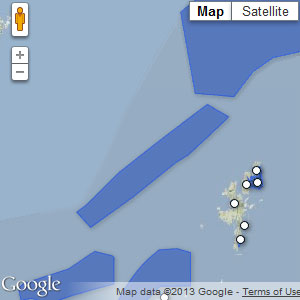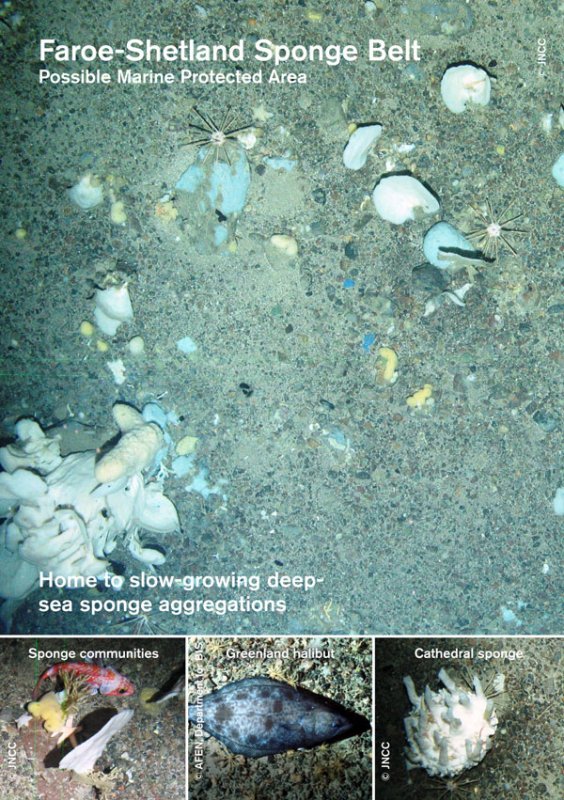 The Faroe-Shetland Channel is a huge rift basin that separates the Scottish and the Faroese continental shelves to the north of Scotland. The Faroe-Shetland Sponge Belt MPA falls on the Scottish side of the channel. Warmer North Atlantic water flowing over sub-zero Norwegian Sea deep water drives a diversity of sea life in the area, including fields of slow-growing deep-sea sponges known as “Ostebund” or “cheese-bottoms” by local fishermen owing to their appearance.
The Faroe-Shetland Channel is a huge rift basin that separates the Scottish and the Faroese continental shelves to the north of Scotland. The Faroe-Shetland Sponge Belt MPA falls on the Scottish side of the channel. Warmer North Atlantic water flowing over sub-zero Norwegian Sea deep water drives a diversity of sea life in the area, including fields of slow-growing deep-sea sponges known as “Ostebund” or “cheese-bottoms” by local fishermen owing to their appearance.
The Faroe-Shetland sponge belt MPA was designated in 2014, and Scottish Government proposed management measures for this and other offshore MPA sites at the end of last year. Save Scottish Seas campaign members have assessed the MPA management proposal for this site as part of its consultation response.
Read our response to the proposed management measures here:
LINK members support the removal of demersal fishing gear (mobile and static) from the mapped Deep Sea Sponge Aggregations (DSSA) and the >800m restriction on mobile demersal gear. However, we are concerned that this provides limited scope for DSSA recovery and a limited buffer for wider impacts. Scientific evidence suggests that areas of highest sediment re-suspension are unfavourable to sponges as sponge feeding and respiration channels can become clogged19; there is some concern that by allowing mobile demersal activities deeper on the slope, the sponge communities may be impacted by sediment re-suspension. We therefore suggest that in line with current scientific advice20, the >800m restriction be extended to >600m.
DSSA create complex habitats supporting high biodiversity and providing refuge for fish, potentially rivalling coldwater coral reefs in terms of functional importance21. DSSA are sources of novel chemical compounds and have a critical ecosystem role in biogeochemical cycling and benthic pelagic coupling (linking benthic ecosystems to pelagic ecosystems via the food web)22. Due to their important functional role, it is imperative that conservation efforts aim to enhance DSSA, allowing expansion of the feature rather than protecting residual areas. Fishing activities have likely greatly reduced the distribution of DSSA which historically is likely to have been extensive. Given that DSSA may be highly susceptible to fragmentation because of short planktonic larval duration and dispersal, increasing the extent of DSSA and DSSA habitat that is protected may be required to prevent reproductive isolation and ensure ecological coherence of the protected populations. It is also possible that unmapped DSSA occur within the site. Therefore, in order to adequately protect the feature from accidental removal or damage, which under JNCC advice could affect its structure and/or function, we support a substantial buffer in all directions that allows for recovery of this vulnerable marine ecosystem and precautionary protection from further damage.
The difficulty in ascertaining exactly where gear is contacting the bottom makes small areas of protection hard to enforce and of limited value in determining whether or not fishing is still actively impacting the sponge beds. LINK members suggest that greater buffers around the management boundaries are needed and/or more observers on fishing vessels with an increase in the frequency of VMS pings within management areas to aid effective enforcement. Additionally, we suggest that the north-east area of offshore subtidal sands and gravels be protected from demersal mobile gear given the very low VMS intensity in this area, allowing for potential recovery/expansion of DSSA and reducing the complexity of enforcement at the site. Additionally, protection in this area would help ensure that a representative range of depths on the continental slope is protected, some representation for which is currently lacking across the network.
A precautionary approach to protecting DSSA is also necessary due to the uncertainty regarding what natural disturbance and predation is required to maintain other features in a natural state. By selectively removing pressures on one or a few species, natural functioning of the ecosystem is not necessarily going to be maintained or restored. Precautionary effective protection of selected patches of seabed is the safer and cheaper option, compared to expensive research projects. Upon review of the network in 2018, we also recommend including coldwater coral reefs (e.g. Lophelia pertusa) as a designated feature for this site, given its presence at the site in the OSPAR threatened/declining habitats dataset 2014, and recent research regarding the importance of this site for L. pertusa connectivity across the Scottish MPA network.
Read our response to the 2013 site consultation here:
Save Scottish Seas campaign members have assessed the Scottish Government’s MPA proposal for this site as part of its consultation response.
LINK supports the designation of the Faroe-Shetland sponge belt possible Nature Conservation MPA for the protection of deep-sea sponge aggregations, ocean quahog aggregations (including sands and gravels as their supporting habitat), offshore subtidal sands and gravels and geodiversity interests (including continental slope channels, iceberg ploughmark fields, prograding wedges, slide deposits, sand wave fields and sediment wave fields). The boundary of the possible MPA is fully supported. This possible MPA has no ecological equivalent for the features and offers the only representation of the particular variant of deep sea sponge aggregations in OSPAR II as well as ocean quahog at the northern extend of its range in OSPAR II. We believe that the large-scale biodiversity feature continental slope should be added to this site, together with appropriate management measures for the associated biodiversity.
We accept the conservation objective of ‘conserve – feature condition uncertain’. However, we note that selection guideline 2d was not considered to be met for the protected biodiversity features in this site as sensitivity analyses concluded that there is a risk that features have been modified by human activity.
Management Options:
Management options for protected features of uncertain condition must be evidence-based, account for the known vulnerability of the protected features to human activities and make appropriate use of the precautionary principle.
We fully support the removal of pressures associated with bottom contact (static and mobile) fishing gear to achieve protection and enhancement of the features. This position is reinforced by the ‘declining’ status assessment of deepsea habitats and ‘many concerns’ and ‘declining’ status of shallow and shelf subtidal sediments in the Faroe-Shetland Channel, in which this possible MPA sits, highlighted by Scotland’s Marine Atlas.
This site is known to be used by white-sided dolphin, sperm whale, long-finned pilot whale and fin whale. These species should be considered when developing management options and in the socioeconomic assessment.Socioeconomic Assessment:
The benefits of conserving deep sea biodiversity in an area of this degree of richness far outweigh the minimal and short lived benefits of trawling in such areas. We are concerned about the inappropriate assumptions made in the socioeconomic assessment when calculating the costs of designation.Check out the official documents relating to the possible Faroe-Shetland sponge belt MPA on the Joint Nature Conservation Committee website.
[1] Faroe-Shetland sponge belt MPA site summary, JNCC

